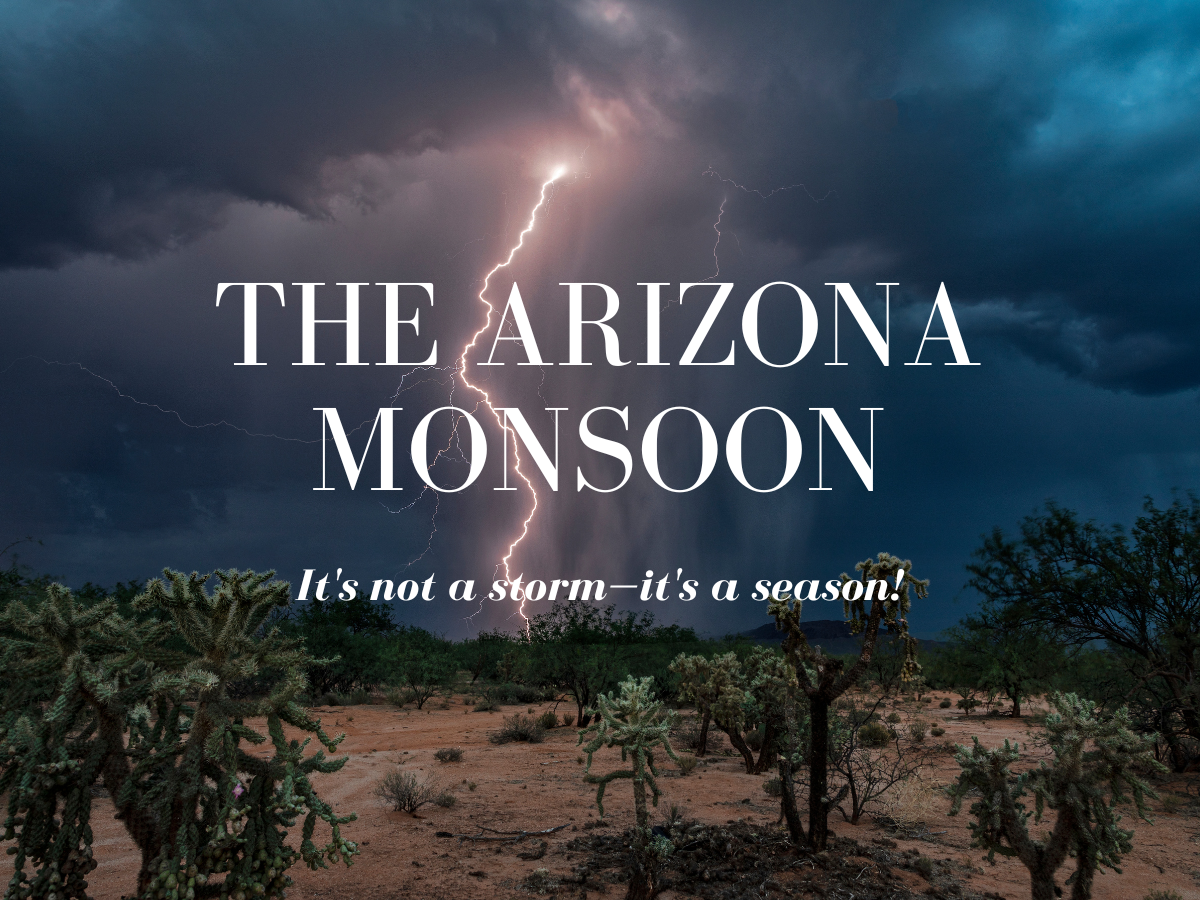Bright, hot, sunny mornings. Stiffly whipped, creamy white clouds building mid-day, darkening the sky shades of elephant gray and dark inky blue as the afternoon progresses. Wind kicking up, birds chattering and any loose vegetation goes flying down the street past your home. Finally, with the dankly sweet smell of creosote perfuming the air, the wall of rain marches in—power washing away all the dust and dirt, and seemingly ushering in a new energy. Ahhhhhh, monsoon—my favorite season.
The Arizona monsoon is a marked by shifting winds and a seasonal change in the weather patterns that occurs in the southwestern United States and northwestern Mexico. It is characterized by the arrival of moisture-laden winds from the Gulf of Mexico and the Pacific Ocean, which can bring heavy rains, thunderstorms, flash flooding, dust storms, and strong winds.
The monsoon season in Arizona typically runs from June 15 to September 30th. However, it can start earlier or later, depending on the year. The peak of the monsoon season is usually in July and August. The start date of the Arizona monsoon was changed in 2008 by the National Weather Service (NWS). Previously, the NWS defined the start of the monsoon as the first day with measurable rainfall in Phoenix. However, this definition was not always consistent, as the first measurable rainfall in Phoenix could occur at different times in different years. The dew point is also a key indicator to the start of the monsoon season and the rains—and weather forecasters here in Tucson keep a keen eye on it.
As needed as these rains are, they can bring hazards. If you are new to Arizona, here are some tips for staying safe this season.
- Have a plan for what to do if you are caught in a dust storm. Dust storms can reduce visibility to zero and make driving dangerous. If you are caught in a dust storm, pull over to the side of the road, turn off your lights, keep your foot OFF the brake and wait for it to pass.
- Monsoon rains can cause dry river and streambeds to fill. Thinking of taking a dip in monsoon flooded areas? I’d advise against it for a multitude of reasons. These can become raging forces of nature within seconds, causing currents that can easily sweep away even large vehicles. In addition, all the desert animals that will be evicted from the flooding will be swimming right alone with you. Rattlesnakes are excellent swimmers, FYI.
- On that note, keep an eye out for wildlife in general during this time. Monsoon storms can drive wildlife out of their homes and into populated areas. In addition, it can be good food hunting time for a variety of predatory animals who will take advantage of the season. If you see a wild animal, do not approach it. Give it plenty of space and let it go on its way.
- Stay indoors during heavy rains. Monsoon storms can produce heavy rains that can lead to flooding and flash floods. If you are outside when a storm starts, take shelter immediately.
- Avoid driving in flooded areas. As mentioned above, floodwaters can be dangerous and can quickly sweep vehicles away. If you see a flooded area, do not attempt to drive through it.
- Be aware of downed power lines. Lightning strikes can knock down power lines. If you see a downed power line, stay away from it and call 911.
- Secure loose outdoor objects. Strong winds can blow loose objects around, causing damage and injuries. Before a storm, secure loose items such as patio furniture, trash cans, and lawn ornaments.
- Check on elderly neighbors and relatives. Elderly people and people with disabilities may be more vulnerable to the effects of a storm. Check on them to make sure they are safe and have what they need.
- Be prepared for power outages. Monsoon storms can sometimes cause power outages. Have a plan in place in case you lose power. This may include having a portable generator, flashlights, and batteries on hand.
- Listen to local news and weather reports. Stay informed about the weather forecast and be prepared to take action if a storm is in the area.
- Lastly, one the real estate front, it a good rule of thumb to check your roof before and after monsoon season. Tiles break and blow away, and roof coating can become degraded. Roofers generally get VERY busy during monsoon season, so plan accordingly.
Stay safe and enjoy your monsoon season!


